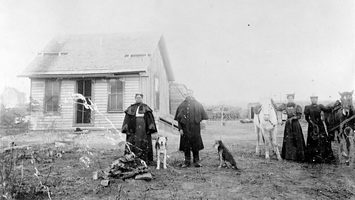The Exodusters and the Black American Migration to Kansas
Confronted by the entrenched, violent reality of white supremacy in the South, tens of thousands of black Americans moved to the Great Plains.

During the Great Migration of 1916 to 1970, more than 6 million black Americans migrated from the rural South to cities in the North, Midwest, and Western United States. In doing so, they transformed American society, culture, and politics for generations to come.
But there was another movement of equal significance to the black freedom movement that has garnered much less public attention. Known as the “Kansas Exodus”--a reference to the biblical exodus out of slavery in Egypt, and thus deeply meaningful to oppressed freedpeople and sharecroppers--it was the first general migration of blacks in America after the Civil War. These “Exodusters” migrated to Kansas and other parts of the Great Plains in large numbers between 1879 and 1881.
Much of what we know about the exodusters comes from the U.S. Senate Select Committee’s investigation of 1880, titled the “Negro Exodus from the Southern States.” The impetus for the investigation were reports of hardships, injustice, and suffering inflicted on black people by white Southern Democrats. Seeking refuge, an estimated 20,000 Exodusters, primarily from Tennessee, Louisiana, Mississippi, and Texas, arrived via steamboat for Kansas, the Oklahoma Territory, and other parts of the Great Plains.
A key figure in the exoduster movement was Benjamin “Pap” Singleton, a prominent carpenter, cabinetmaker, and undertaker from Tennessee. During slavery, he attempted to flee several times before finally making good on his escape to Canada via the Underground Railroad. He later moved on to Michigan and then Tennessee.
As a businessman and undertaker, he witnessed the bloody aftermath of violence inflicted on black Americans by former Confederates during the paramilitary insurrections that ended Reconstruction. He also grew concerned about the ways wealthy white landowners exploited poor black sharecroppers, reversing many of the gains made following the civil war.
Realizing the power of southern white supremacy after the Civil War, in 1869 Singleton founded the Tennessee Real Estate & Homestead Association with the goal of creating an organization that could help blacks move and establish safe, black colonies in Kansas and beyond.
Kansas -- nicknamed “Bleeding Kansas” in the 1850s for its fight to become a free state, represented a relative safe haven -- was a place where black Americans could experience some semblance of freedom and prosperity. And with the enactment of the Homestead Act of 1862, swaths of inexpensive land became available for new residents willing to settle on the plains.
Unfortunately, the routes taken by many of the migrants went through swampy terrain riddled with yellow fever and other diseases. As a result, many arrived sick and unprepared to embark on a new life. Few came with any money, resulting in the need to borrow or beg for food, shelter, and other resources.
Although the Kansas Constitution had promised opportunity to people of all backgrounds, Exodusters encountered many hardships in their new home. This was particularly true when it came to cultivating land, establishing homes, and building businesses with limited resources. In response, Kansas Governor John St. John established the Freedmen’s Relief Fund in 1879 with the intent of delivering vital care and resources to these new Kansans.
Over time, some moved to the neighboring territory of Oklahoma and a few even returned to the South. However, many stayed in Kansas, with large communities located in major cities like Topeka and Kansas City. According to the state census, only 151 free blacks and 192 slaves were living in the territory in 1855. But after the migration, 17,108 blacks were lived in the state.
Perhaps the most widely known of all the new, black communities in Kansas was the city of Nicodemus, nestled on the northwest Kansas plains. Established in 1877 by a group of freedmen from Scott County, Kentucky, the town was named after a legendary, enslaved African prince who had purchased his own freedom.
The city had the distinction of being the first black community west of the Mississippi. Like many areas where the black migrants attempted to settle, the city had a harsh beginning due to scarce resources and unfavorable weather conditions for raising crops. Nevertheless, the settlers persevered and the city grew and prospered for several generations.
The relative freedom and prosperity of black Kansans created space for civil rights activism in the twentieth century. It is no accident that the groundbreaking Brown v. Board of Education case took place in Topeka, Kansas nearly a century later. By the 1950s, black Kansans had built many independent communities, a dense network of social institutions, and a determination to fight for racial equality.
The “Great Exodus to Kansas” reflected the will of the formerly enslaved to carve out freedom for themselves in defiance of the white supremacist regimes of the post-Reconstruction South. They did so with vanishingly little external support. The vibrant communities they created in Kansas and other Great Plains states offered important models of self-governance and community building that served as catalysts for the freedom struggle for generations to come.
Sources:
Exodusters: African American Migration to the Great Plains, Digital Public Library of America,
Exoduster: Kansapedia: Kansas Historical Society